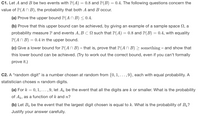
A First Course in Probability (10th Edition)
10th Edition
ISBN: 9780134753119
Author: Sheldon Ross
Publisher: PEARSON
expand_more
expand_more
format_list_bulleted
Question
solution for c2

Transcribed Image Text:C1. Let A and B be two events with P(A) = 0.8 and P(B) = 0.4. The following questions concern the
value of P(An B), the probability that both A and B occur.
(a) Prove the upper bound P(AN B) < 0.4.
(b) Prove that this upper bound can be achieved, by giving an example of a sample space N, a
probability measure P and events A, B CN such that P(A) = 0.8 and P(B) = 0.4, with equality
P(AN B) = 0.4 in the upper bound.
(c) Give a lower bound for P(AN B) – that is, prove that P(A n B) > something – and show that
this lower bound can be achieved. (Try to work out the correct bound, even if you can't formally
prove it.)
C2. A “random digit" is a number chosen at random from {0,1, ...,9}, each with equal probability. A
statistician choses n random digits.
(a) For k = 0, 1,... , 9, let A be the event that all the digits are k or smaller. What is the probability
of A, as a function of k and n?
(b) Let Br be the event that the largest digit chosen is equal to k. What is the probability of B?
Justify your answer carefully.
Expert Solution
This question has been solved!
Explore an expertly crafted, step-by-step solution for a thorough understanding of key concepts.
This is a popular solution
Trending nowThis is a popular solution!
Step by stepSolved in 2 steps with 2 images

Knowledge Booster
Similar questions
Recommended textbooks for you
 A First Course in Probability (10th Edition)ProbabilityISBN:9780134753119Author:Sheldon RossPublisher:PEARSON
A First Course in Probability (10th Edition)ProbabilityISBN:9780134753119Author:Sheldon RossPublisher:PEARSON

A First Course in Probability (10th Edition)
Probability
ISBN:9780134753119
Author:Sheldon Ross
Publisher:PEARSON
